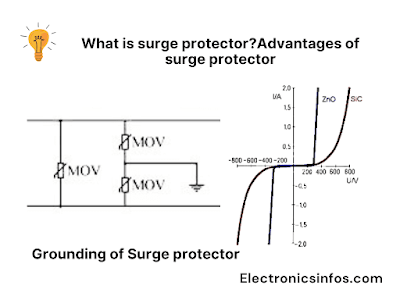What is a surge protector?
A surge protector is also known as a surge suppressor or surge arrester. it protects electrical devices from voltage spikes or surges. It is commonly used to protect sensitive electronic equipment such as computers, televisions, and home entertainment systems.
Types of Surge Protector
- Plug-In Surge Protectors
- Power Strip Surge Protectors
- Wall-Mount Surge Protectors
- Whole-House Surge Protectors
- Modular Surge Protectors
- Data Line Surge Protectors
- Portable Surge Protectors
Why We Need Surge Protector?
The primary reason for using surge protectors is to protect electronic devices and appliances from power surges. Surges can occur due to lightning strikes, power grid fluctuations, or switching operations.
Surge protectors help to limit the voltage that reaches your devices, thus preventing damage.
- Surge protectors help to ensure that your data remains safe during power fluctuations.
- Some electronic devices come with warranties that may be voided if damage occurs due to power surges.
- power surges can lead to electrical fires, especially if the surge causes overheating within electronic devices.
- Surge protectors have multiple outlets, allowing you to connect devices to a single power source safely.
Why do voltage fluctuations Occur?
Voltage spikes can occur for various reasons, including lightning strikes, power grid fluctuations, electrical faults, or turning on/off high-powered appliances. These spikes can exceed the normal voltage levels and potentially damage electronic components within devices, leading to malfunctions or permanent failure.
What does a surge protector do?
A surge protector, also known as a surge suppressor or a power strip with surge protection, is a device designed to protect electrical devices from voltage spikes or surges. It acts as a barrier between the electrical power source and the connected devices to prevent excessive voltage from reaching and damaging them.
Working Principle of Surge Protector
The working principle of a surge protector involves several components to effectively divert excess voltage and protect connected devices.
- Metal Oxide Varistors (MOVs) or Gas Discharge Tubes
- Clamping Voltage
- Voltage Surge Detection
- Voltage Diversion
- Grounding
- Resettable Feature
Metal Oxide Varistors (MOVs)
Surge protectors have MOVs or gas discharge tubes as voltage-sensitive switches. These components have high resistance at normal voltage levels but quickly change to a low-resistance state when voltage exceeds a certain threshold.
Clamping Voltage
Surge protectors have a clamping voltage, which is the maximum voltage level at which they allow current to flow to connected devices. When the voltage remains below the clamping voltage, the surge protector remains in a high-resistance state, offering no interference to the electrical flow.
Voltage Surge Detection
When a voltage surge occurs, the voltage level rapidly rises above the normal range. The surge protector's components detect this increase and respond by transitioning to a low-resistance state.
Voltage Diversion
Once the surge protector detects a voltage surge and enters a low-resistance state, it diverts the excess voltage away from the connected devices. The MOVs or gas discharge tubes provide a path of lower resistance through which the excess voltage can flow.
Grounding
Surge protectors are equipped with a grounding wire or a ground pin in their plug. This grounding connection provides a safe path for the excess voltage to be redirected to the ground.
Resettable Feature
Some surge protectors may include a resettable feature that automatically restores their protection capabilities after a surge event. This feature ensures ongoing protection even if multiple surges occur.
Advantages of Surge Protectors
Surge protectors have several advantages in protecting your electronic devices. Here are some key advantages of using surge protectors
- Protection against Voltage Spikes
- Avoid starting a Fire
- Enhanced Device Longevity
- Cost Savings
- Multiple Device Protection
Protection against Voltage Spikes
The primary advantage of surge protectors is their ability to safeguard electronic devices from voltage spikes. They divert excess voltage away from the connected devices. it prevents them from reaching and potentially damaging sensitive components.
This protection is particularly important in areas prone to lightning strikes, power grid fluctuations, or electrical faults.
Avoid Starting a Fire
Surge protectors provide complete protection against starting a fire.
Enhanced Device Longevity
By preventing damage from voltage surges, surge protectors help extend the lifespan of your electronic devices. Sudden spikes in voltage can cause immediate failures or degrade components over time.
5 Best Battery Backup Surge Protectors
Cost Savings
Repairing or replacing damaged electronic devices can be expensive. Surge protectors act as a cost-effective insurance policy.it reduce the likelihood of equipment damage and the need for costly repairs or replacements.
Multiple Device Protection
Surge protectors have multiple outlets.it allowing you to connect multiple devices simultaneously. This means you can protect multiple electronics with a single surge protector.
Frequently Asked Questions – FAQs
What is a Surge Protector?
A surge protector is a device that protects electrical equipment from voltage spikes.
How does a surge protector work?
Surge protectors work by diverting excess voltage away from the protected devices. They use components like Metal Oxide Varistors (MOVs) that change resistance with the voltage level to manage the excess energy.
Where are surge protectors commonly used?
Surge protectors are used in computers, televisions, refrigerators, and other sensitive equipment from power surges.
What types of surge protectors are available?
There are several types of surge protectors including power strips with built-in surge protection, wall-mounted surge protectors, whole-house surge protectors, and specialized devices for phone lines and coaxial cables.
What is the difference between a surge protector and a power strip?
A power strip simply provides multiple outlets for plugging in devices but does not offer protection against voltage spikes. A surge protector includes components that protect connected devices from power surges.
How does a whole-house surge protector differ from a plug-in surge protector?
A whole-house surge protector is installed at the electrical panel and provides protection for all the circuits in the home, while plug-in surge protectors are used for individual devices or groups of devices at the point of use.


.png)



.png)



0 Comments
please do not insert spam links